Human Resource Management Report: Calsonic Kansei, HRM Practices
VerifiedAdded on 2020/01/15
|13
|4139
|166
Report
AI Summary
This report delves into the human resource management (HRM) practices of Calsonic Kansei, an automotive company operating in the UK. It examines various aspects of HRM, including recruitment and selection, training and development, legal considerations, remuneration and reward packages, and workforce issues. The report highlights the company's approach to attracting and retaining skilled employees, its training programs, and its adherence to legal and ethical standards. Furthermore, it explores the company's strategies for performance management, including performance planning, training, and appraisal. The report also addresses key workforce issues such as leadership, diversity, and conflict management, providing insights into how Calsonic Kansei navigates these challenges. Through this analysis, the report offers a comprehensive understanding of HRM principles and their practical application within an automotive manufacturing context.
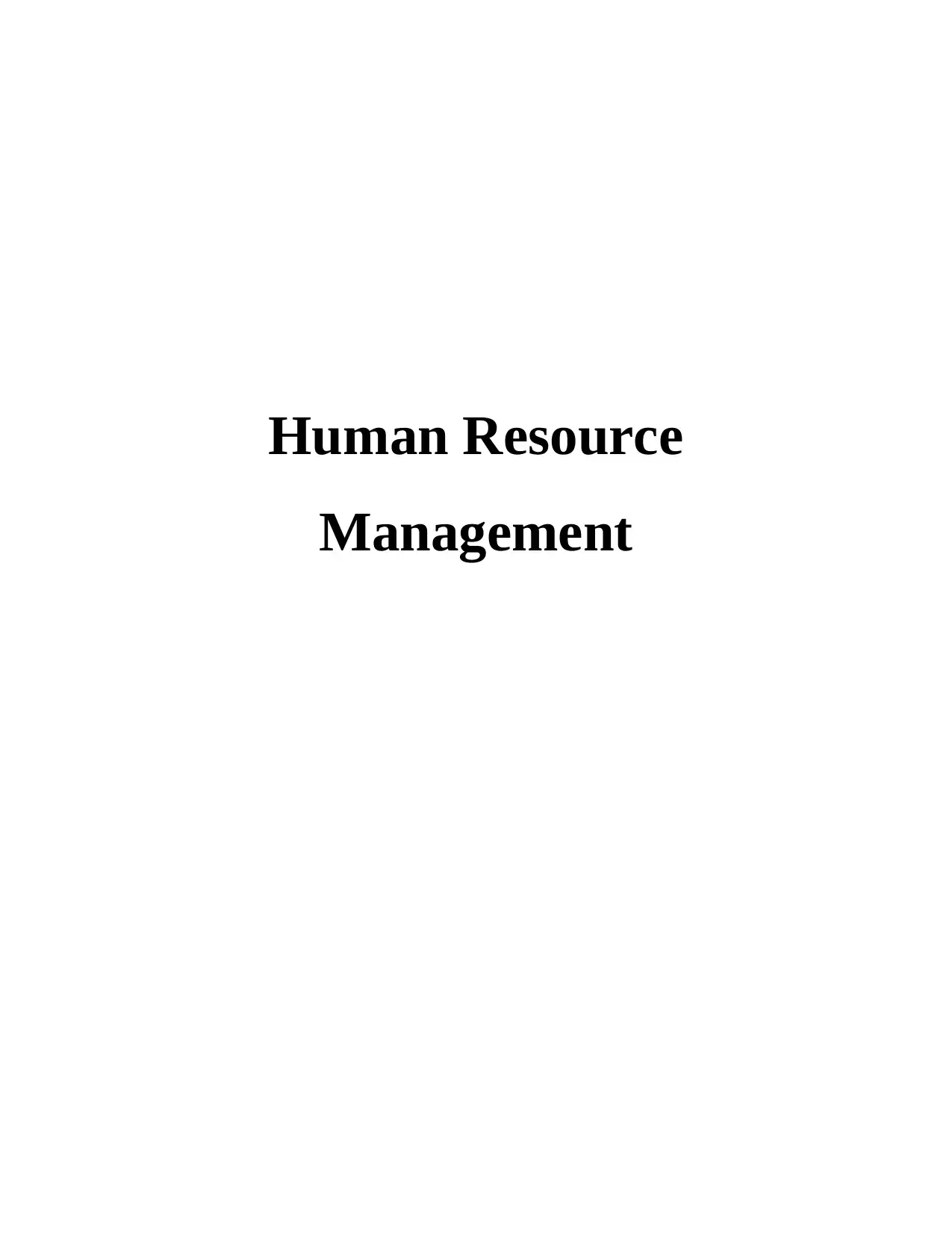
Human Resource
Management
Management
Paraphrase This Document
Need a fresh take? Get an instant paraphrase of this document with our AI Paraphraser
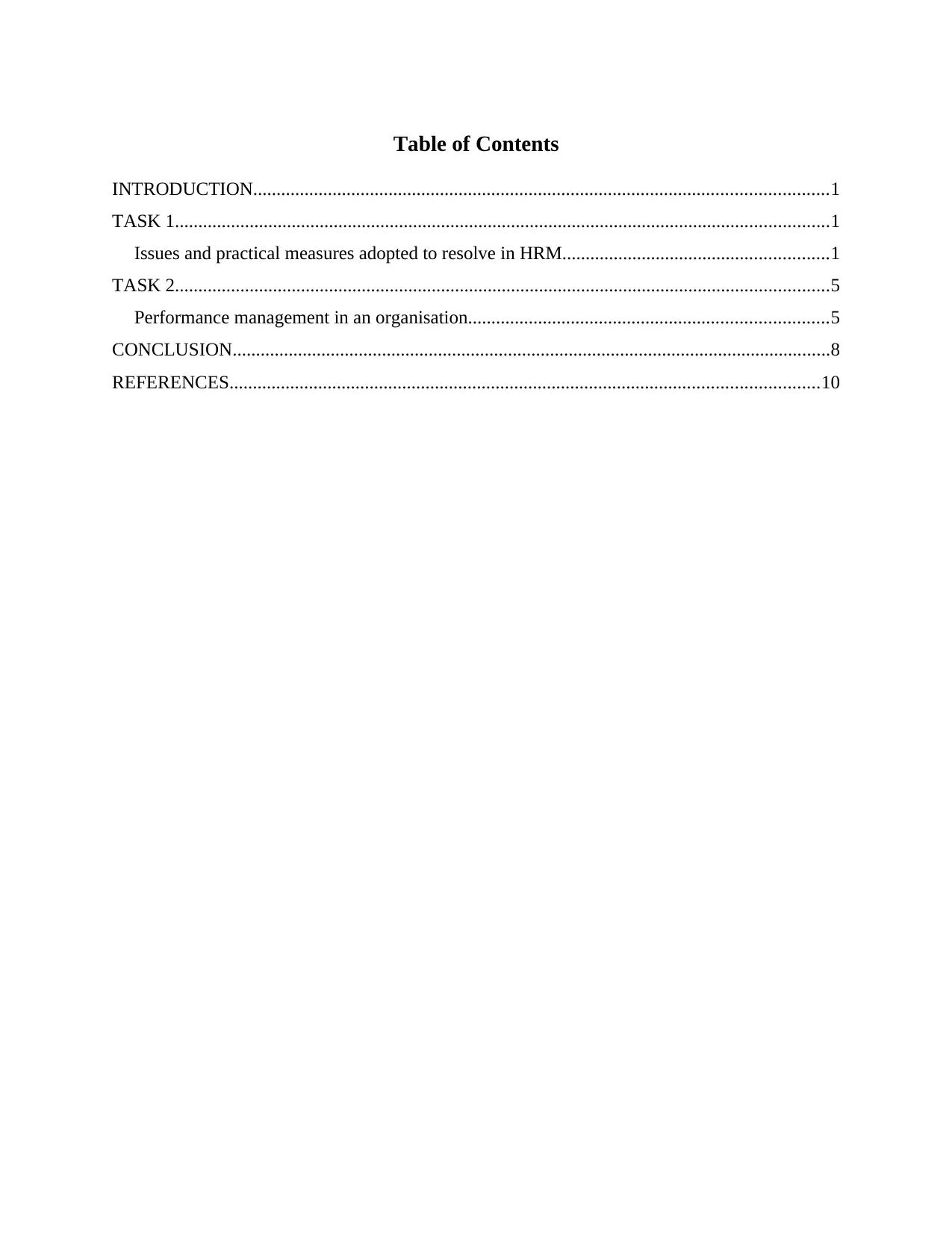
Table of Contents
INTRODUCTION...........................................................................................................................1
TASK 1............................................................................................................................................1
Issues and practical measures adopted to resolve in HRM.........................................................1
TASK 2............................................................................................................................................5
Performance management in an organisation.............................................................................5
CONCLUSION................................................................................................................................8
REFERENCES..............................................................................................................................10
INTRODUCTION...........................................................................................................................1
TASK 1............................................................................................................................................1
Issues and practical measures adopted to resolve in HRM.........................................................1
TASK 2............................................................................................................................................5
Performance management in an organisation.............................................................................5
CONCLUSION................................................................................................................................8
REFERENCES..............................................................................................................................10
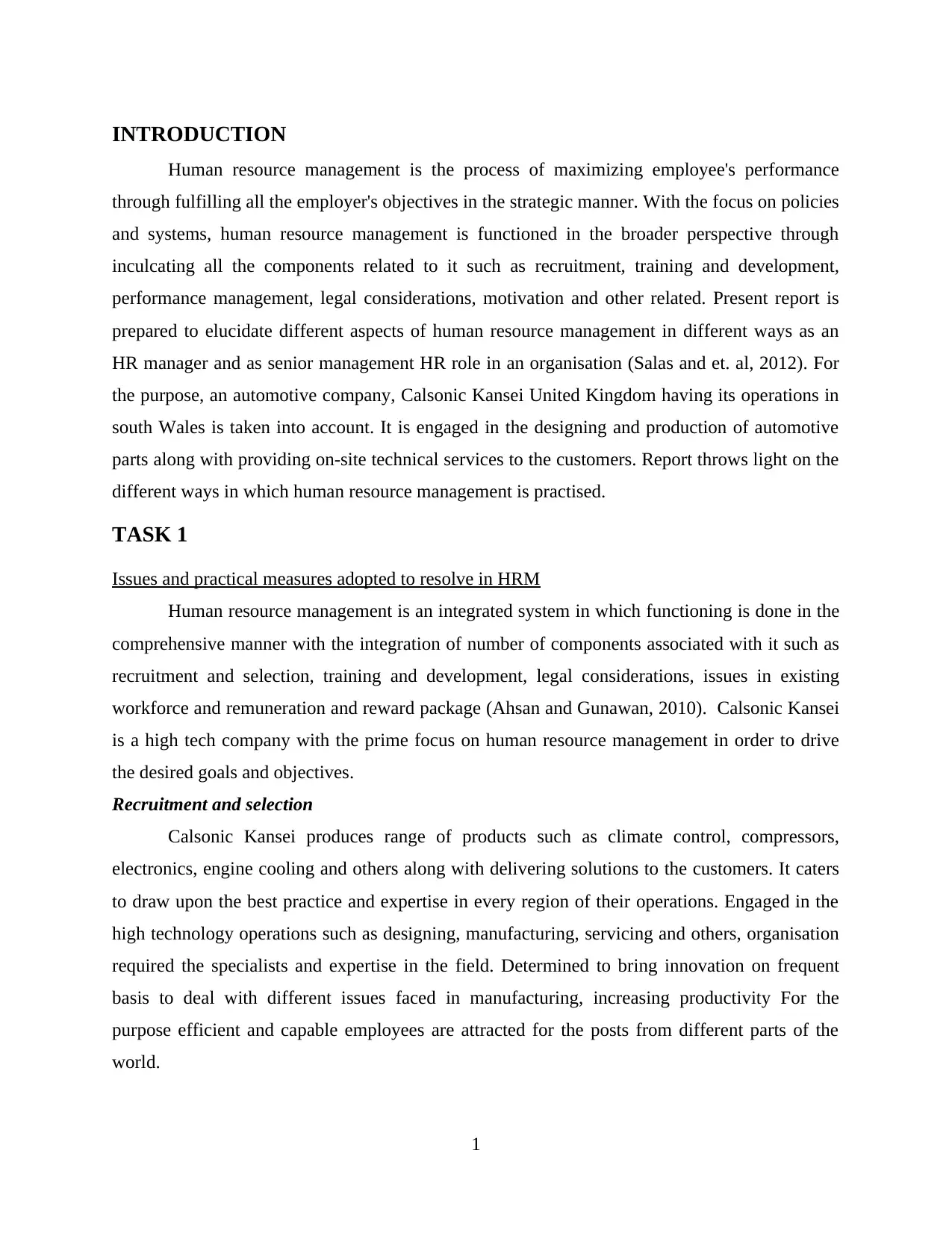
INTRODUCTION
Human resource management is the process of maximizing employee's performance
through fulfilling all the employer's objectives in the strategic manner. With the focus on policies
and systems, human resource management is functioned in the broader perspective through
inculcating all the components related to it such as recruitment, training and development,
performance management, legal considerations, motivation and other related. Present report is
prepared to elucidate different aspects of human resource management in different ways as an
HR manager and as senior management HR role in an organisation (Salas and et. al, 2012). For
the purpose, an automotive company, Calsonic Kansei United Kingdom having its operations in
south Wales is taken into account. It is engaged in the designing and production of automotive
parts along with providing on-site technical services to the customers. Report throws light on the
different ways in which human resource management is practised.
TASK 1
Issues and practical measures adopted to resolve in HRM
Human resource management is an integrated system in which functioning is done in the
comprehensive manner with the integration of number of components associated with it such as
recruitment and selection, training and development, legal considerations, issues in existing
workforce and remuneration and reward package (Ahsan and Gunawan, 2010). Calsonic Kansei
is a high tech company with the prime focus on human resource management in order to drive
the desired goals and objectives.
Recruitment and selection
Calsonic Kansei produces range of products such as climate control, compressors,
electronics, engine cooling and others along with delivering solutions to the customers. It caters
to draw upon the best practice and expertise in every region of their operations. Engaged in the
high technology operations such as designing, manufacturing, servicing and others, organisation
required the specialists and expertise in the field. Determined to bring innovation on frequent
basis to deal with different issues faced in manufacturing, increasing productivity For the
purpose efficient and capable employees are attracted for the posts from different parts of the
world.
1
Human resource management is the process of maximizing employee's performance
through fulfilling all the employer's objectives in the strategic manner. With the focus on policies
and systems, human resource management is functioned in the broader perspective through
inculcating all the components related to it such as recruitment, training and development,
performance management, legal considerations, motivation and other related. Present report is
prepared to elucidate different aspects of human resource management in different ways as an
HR manager and as senior management HR role in an organisation (Salas and et. al, 2012). For
the purpose, an automotive company, Calsonic Kansei United Kingdom having its operations in
south Wales is taken into account. It is engaged in the designing and production of automotive
parts along with providing on-site technical services to the customers. Report throws light on the
different ways in which human resource management is practised.
TASK 1
Issues and practical measures adopted to resolve in HRM
Human resource management is an integrated system in which functioning is done in the
comprehensive manner with the integration of number of components associated with it such as
recruitment and selection, training and development, legal considerations, issues in existing
workforce and remuneration and reward package (Ahsan and Gunawan, 2010). Calsonic Kansei
is a high tech company with the prime focus on human resource management in order to drive
the desired goals and objectives.
Recruitment and selection
Calsonic Kansei produces range of products such as climate control, compressors,
electronics, engine cooling and others along with delivering solutions to the customers. It caters
to draw upon the best practice and expertise in every region of their operations. Engaged in the
high technology operations such as designing, manufacturing, servicing and others, organisation
required the specialists and expertise in the field. Determined to bring innovation on frequent
basis to deal with different issues faced in manufacturing, increasing productivity For the
purpose efficient and capable employees are attracted for the posts from different parts of the
world.
1
⊘ This is a preview!⊘
Do you want full access?
Subscribe today to unlock all pages.

Trusted by 1+ million students worldwide
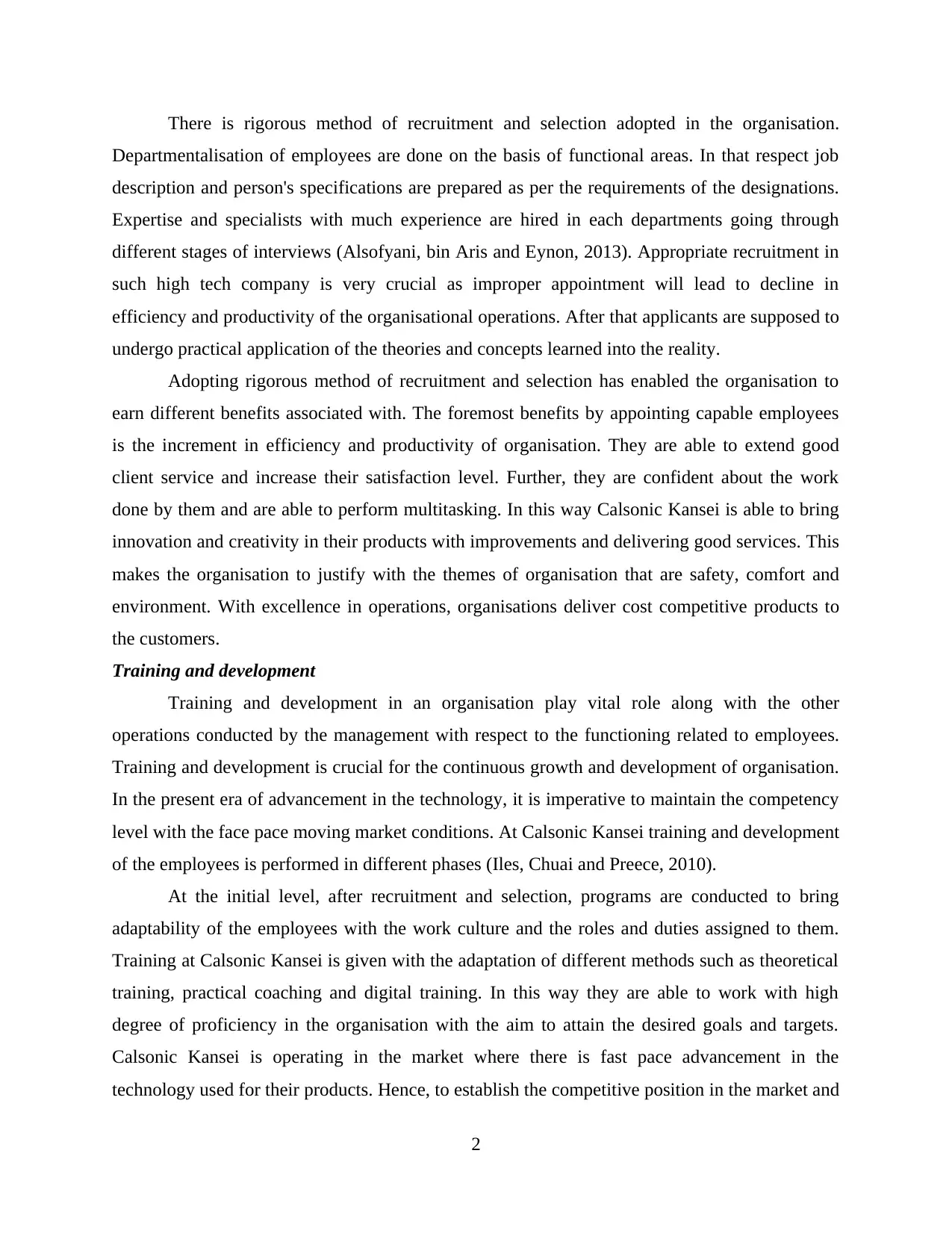
There is rigorous method of recruitment and selection adopted in the organisation.
Departmentalisation of employees are done on the basis of functional areas. In that respect job
description and person's specifications are prepared as per the requirements of the designations.
Expertise and specialists with much experience are hired in each departments going through
different stages of interviews (Alsofyani, bin Aris and Eynon, 2013). Appropriate recruitment in
such high tech company is very crucial as improper appointment will lead to decline in
efficiency and productivity of the organisational operations. After that applicants are supposed to
undergo practical application of the theories and concepts learned into the reality.
Adopting rigorous method of recruitment and selection has enabled the organisation to
earn different benefits associated with. The foremost benefits by appointing capable employees
is the increment in efficiency and productivity of organisation. They are able to extend good
client service and increase their satisfaction level. Further, they are confident about the work
done by them and are able to perform multitasking. In this way Calsonic Kansei is able to bring
innovation and creativity in their products with improvements and delivering good services. This
makes the organisation to justify with the themes of organisation that are safety, comfort and
environment. With excellence in operations, organisations deliver cost competitive products to
the customers.
Training and development
Training and development in an organisation play vital role along with the other
operations conducted by the management with respect to the functioning related to employees.
Training and development is crucial for the continuous growth and development of organisation.
In the present era of advancement in the technology, it is imperative to maintain the competency
level with the face pace moving market conditions. At Calsonic Kansei training and development
of the employees is performed in different phases (Iles, Chuai and Preece, 2010).
At the initial level, after recruitment and selection, programs are conducted to bring
adaptability of the employees with the work culture and the roles and duties assigned to them.
Training at Calsonic Kansei is given with the adaptation of different methods such as theoretical
training, practical coaching and digital training. In this way they are able to work with high
degree of proficiency in the organisation with the aim to attain the desired goals and targets.
Calsonic Kansei is operating in the market where there is fast pace advancement in the
technology used for their products. Hence, to establish the competitive position in the market and
2
Departmentalisation of employees are done on the basis of functional areas. In that respect job
description and person's specifications are prepared as per the requirements of the designations.
Expertise and specialists with much experience are hired in each departments going through
different stages of interviews (Alsofyani, bin Aris and Eynon, 2013). Appropriate recruitment in
such high tech company is very crucial as improper appointment will lead to decline in
efficiency and productivity of the organisational operations. After that applicants are supposed to
undergo practical application of the theories and concepts learned into the reality.
Adopting rigorous method of recruitment and selection has enabled the organisation to
earn different benefits associated with. The foremost benefits by appointing capable employees
is the increment in efficiency and productivity of organisation. They are able to extend good
client service and increase their satisfaction level. Further, they are confident about the work
done by them and are able to perform multitasking. In this way Calsonic Kansei is able to bring
innovation and creativity in their products with improvements and delivering good services. This
makes the organisation to justify with the themes of organisation that are safety, comfort and
environment. With excellence in operations, organisations deliver cost competitive products to
the customers.
Training and development
Training and development in an organisation play vital role along with the other
operations conducted by the management with respect to the functioning related to employees.
Training and development is crucial for the continuous growth and development of organisation.
In the present era of advancement in the technology, it is imperative to maintain the competency
level with the face pace moving market conditions. At Calsonic Kansei training and development
of the employees is performed in different phases (Iles, Chuai and Preece, 2010).
At the initial level, after recruitment and selection, programs are conducted to bring
adaptability of the employees with the work culture and the roles and duties assigned to them.
Training at Calsonic Kansei is given with the adaptation of different methods such as theoretical
training, practical coaching and digital training. In this way they are able to work with high
degree of proficiency in the organisation with the aim to attain the desired goals and targets.
Calsonic Kansei is operating in the market where there is fast pace advancement in the
technology used for their products. Hence, to establish the competitive position in the market and
2
Paraphrase This Document
Need a fresh take? Get an instant paraphrase of this document with our AI Paraphraser
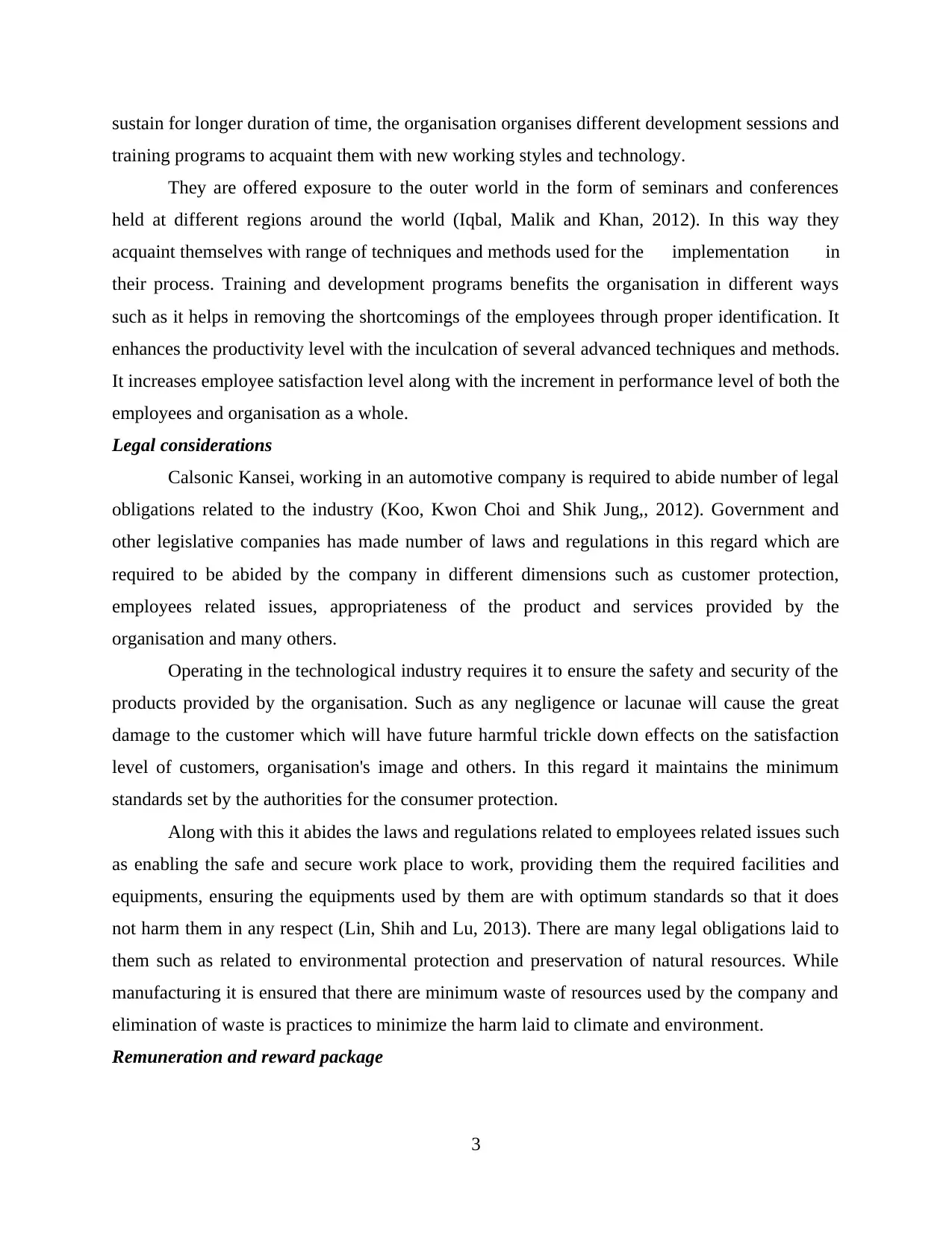
sustain for longer duration of time, the organisation organises different development sessions and
training programs to acquaint them with new working styles and technology.
They are offered exposure to the outer world in the form of seminars and conferences
held at different regions around the world (Iqbal, Malik and Khan, 2012). In this way they
acquaint themselves with range of techniques and methods used for the implementation in
their process. Training and development programs benefits the organisation in different ways
such as it helps in removing the shortcomings of the employees through proper identification. It
enhances the productivity level with the inculcation of several advanced techniques and methods.
It increases employee satisfaction level along with the increment in performance level of both the
employees and organisation as a whole.
Legal considerations
Calsonic Kansei, working in an automotive company is required to abide number of legal
obligations related to the industry (Koo, Kwon Choi and Shik Jung,, 2012). Government and
other legislative companies has made number of laws and regulations in this regard which are
required to be abided by the company in different dimensions such as customer protection,
employees related issues, appropriateness of the product and services provided by the
organisation and many others.
Operating in the technological industry requires it to ensure the safety and security of the
products provided by the organisation. Such as any negligence or lacunae will cause the great
damage to the customer which will have future harmful trickle down effects on the satisfaction
level of customers, organisation's image and others. In this regard it maintains the minimum
standards set by the authorities for the consumer protection.
Along with this it abides the laws and regulations related to employees related issues such
as enabling the safe and secure work place to work, providing them the required facilities and
equipments, ensuring the equipments used by them are with optimum standards so that it does
not harm them in any respect (Lin, Shih and Lu, 2013). There are many legal obligations laid to
them such as related to environmental protection and preservation of natural resources. While
manufacturing it is ensured that there are minimum waste of resources used by the company and
elimination of waste is practices to minimize the harm laid to climate and environment.
Remuneration and reward package
3
training programs to acquaint them with new working styles and technology.
They are offered exposure to the outer world in the form of seminars and conferences
held at different regions around the world (Iqbal, Malik and Khan, 2012). In this way they
acquaint themselves with range of techniques and methods used for the implementation in
their process. Training and development programs benefits the organisation in different ways
such as it helps in removing the shortcomings of the employees through proper identification. It
enhances the productivity level with the inculcation of several advanced techniques and methods.
It increases employee satisfaction level along with the increment in performance level of both the
employees and organisation as a whole.
Legal considerations
Calsonic Kansei, working in an automotive company is required to abide number of legal
obligations related to the industry (Koo, Kwon Choi and Shik Jung,, 2012). Government and
other legislative companies has made number of laws and regulations in this regard which are
required to be abided by the company in different dimensions such as customer protection,
employees related issues, appropriateness of the product and services provided by the
organisation and many others.
Operating in the technological industry requires it to ensure the safety and security of the
products provided by the organisation. Such as any negligence or lacunae will cause the great
damage to the customer which will have future harmful trickle down effects on the satisfaction
level of customers, organisation's image and others. In this regard it maintains the minimum
standards set by the authorities for the consumer protection.
Along with this it abides the laws and regulations related to employees related issues such
as enabling the safe and secure work place to work, providing them the required facilities and
equipments, ensuring the equipments used by them are with optimum standards so that it does
not harm them in any respect (Lin, Shih and Lu, 2013). There are many legal obligations laid to
them such as related to environmental protection and preservation of natural resources. While
manufacturing it is ensured that there are minimum waste of resources used by the company and
elimination of waste is practices to minimize the harm laid to climate and environment.
Remuneration and reward package
3
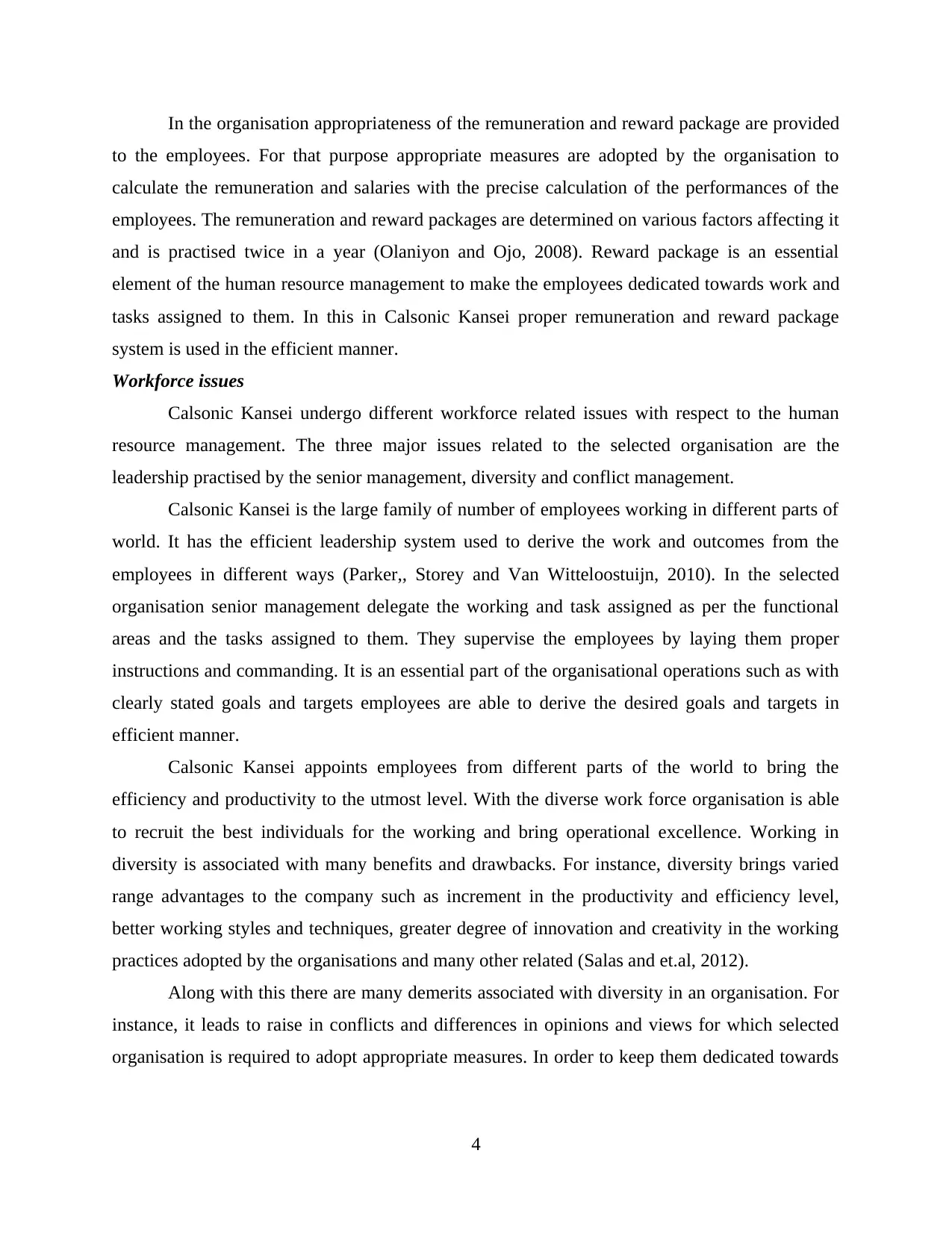
In the organisation appropriateness of the remuneration and reward package are provided
to the employees. For that purpose appropriate measures are adopted by the organisation to
calculate the remuneration and salaries with the precise calculation of the performances of the
employees. The remuneration and reward packages are determined on various factors affecting it
and is practised twice in a year (Olaniyon and Ojo, 2008). Reward package is an essential
element of the human resource management to make the employees dedicated towards work and
tasks assigned to them. In this in Calsonic Kansei proper remuneration and reward package
system is used in the efficient manner.
Workforce issues
Calsonic Kansei undergo different workforce related issues with respect to the human
resource management. The three major issues related to the selected organisation are the
leadership practised by the senior management, diversity and conflict management.
Calsonic Kansei is the large family of number of employees working in different parts of
world. It has the efficient leadership system used to derive the work and outcomes from the
employees in different ways (Parker,, Storey and Van Witteloostuijn, 2010). In the selected
organisation senior management delegate the working and task assigned as per the functional
areas and the tasks assigned to them. They supervise the employees by laying them proper
instructions and commanding. It is an essential part of the organisational operations such as with
clearly stated goals and targets employees are able to derive the desired goals and targets in
efficient manner.
Calsonic Kansei appoints employees from different parts of the world to bring the
efficiency and productivity to the utmost level. With the diverse work force organisation is able
to recruit the best individuals for the working and bring operational excellence. Working in
diversity is associated with many benefits and drawbacks. For instance, diversity brings varied
range advantages to the company such as increment in the productivity and efficiency level,
better working styles and techniques, greater degree of innovation and creativity in the working
practices adopted by the organisations and many other related (Salas and et.al, 2012).
Along with this there are many demerits associated with diversity in an organisation. For
instance, it leads to raise in conflicts and differences in opinions and views for which selected
organisation is required to adopt appropriate measures. In order to keep them dedicated towards
4
to the employees. For that purpose appropriate measures are adopted by the organisation to
calculate the remuneration and salaries with the precise calculation of the performances of the
employees. The remuneration and reward packages are determined on various factors affecting it
and is practised twice in a year (Olaniyon and Ojo, 2008). Reward package is an essential
element of the human resource management to make the employees dedicated towards work and
tasks assigned to them. In this in Calsonic Kansei proper remuneration and reward package
system is used in the efficient manner.
Workforce issues
Calsonic Kansei undergo different workforce related issues with respect to the human
resource management. The three major issues related to the selected organisation are the
leadership practised by the senior management, diversity and conflict management.
Calsonic Kansei is the large family of number of employees working in different parts of
world. It has the efficient leadership system used to derive the work and outcomes from the
employees in different ways (Parker,, Storey and Van Witteloostuijn, 2010). In the selected
organisation senior management delegate the working and task assigned as per the functional
areas and the tasks assigned to them. They supervise the employees by laying them proper
instructions and commanding. It is an essential part of the organisational operations such as with
clearly stated goals and targets employees are able to derive the desired goals and targets in
efficient manner.
Calsonic Kansei appoints employees from different parts of the world to bring the
efficiency and productivity to the utmost level. With the diverse work force organisation is able
to recruit the best individuals for the working and bring operational excellence. Working in
diversity is associated with many benefits and drawbacks. For instance, diversity brings varied
range advantages to the company such as increment in the productivity and efficiency level,
better working styles and techniques, greater degree of innovation and creativity in the working
practices adopted by the organisations and many other related (Salas and et.al, 2012).
Along with this there are many demerits associated with diversity in an organisation. For
instance, it leads to raise in conflicts and differences in opinions and views for which selected
organisation is required to adopt appropriate measures. In order to keep them dedicated towards
4
⊘ This is a preview!⊘
Do you want full access?
Subscribe today to unlock all pages.

Trusted by 1+ million students worldwide
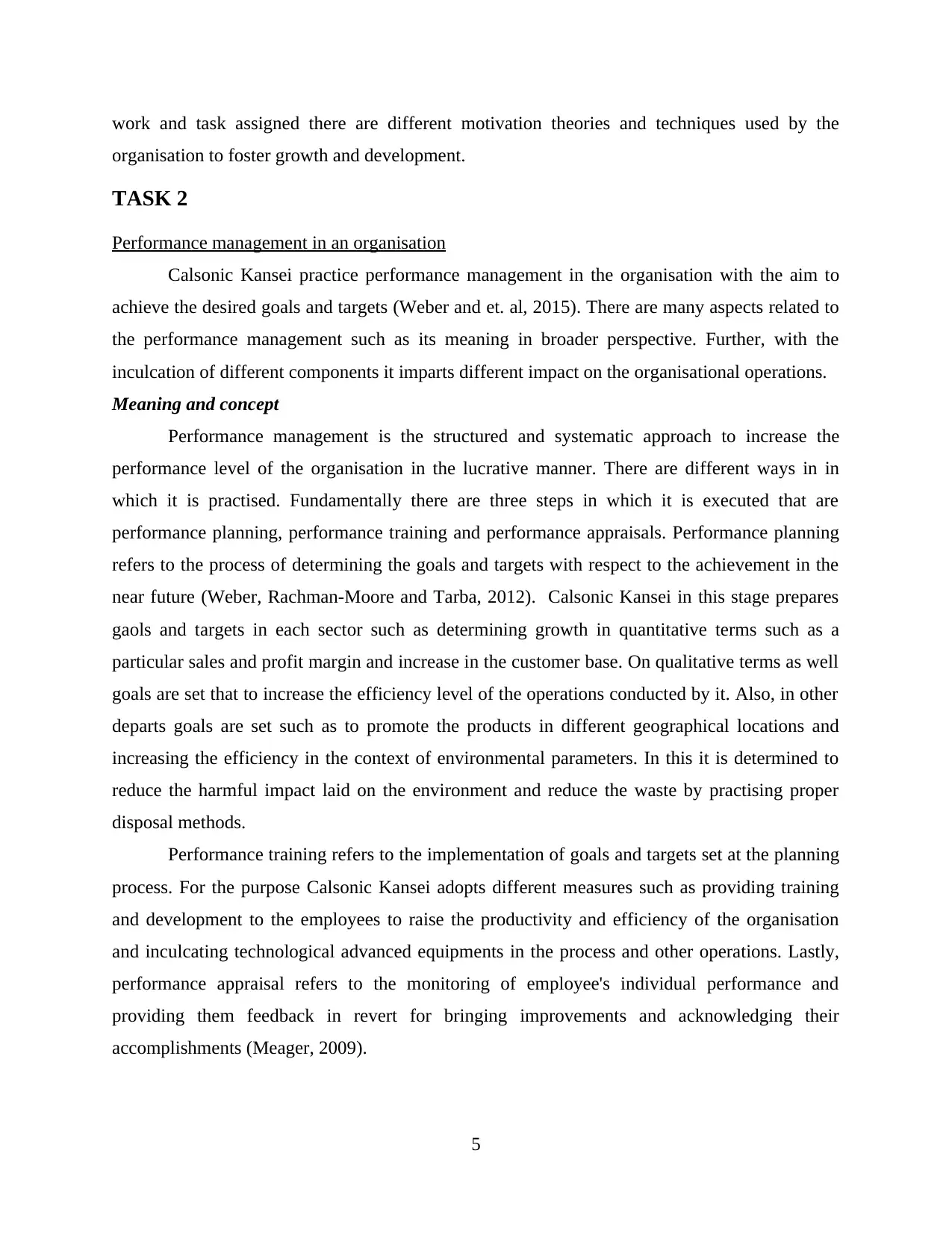
work and task assigned there are different motivation theories and techniques used by the
organisation to foster growth and development.
TASK 2
Performance management in an organisation
Calsonic Kansei practice performance management in the organisation with the aim to
achieve the desired goals and targets (Weber and et. al, 2015). There are many aspects related to
the performance management such as its meaning in broader perspective. Further, with the
inculcation of different components it imparts different impact on the organisational operations.
Meaning and concept
Performance management is the structured and systematic approach to increase the
performance level of the organisation in the lucrative manner. There are different ways in in
which it is practised. Fundamentally there are three steps in which it is executed that are
performance planning, performance training and performance appraisals. Performance planning
refers to the process of determining the goals and targets with respect to the achievement in the
near future (Weber, Rachman-Moore and Tarba, 2012). Calsonic Kansei in this stage prepares
gaols and targets in each sector such as determining growth in quantitative terms such as a
particular sales and profit margin and increase in the customer base. On qualitative terms as well
goals are set that to increase the efficiency level of the operations conducted by it. Also, in other
departs goals are set such as to promote the products in different geographical locations and
increasing the efficiency in the context of environmental parameters. In this it is determined to
reduce the harmful impact laid on the environment and reduce the waste by practising proper
disposal methods.
Performance training refers to the implementation of goals and targets set at the planning
process. For the purpose Calsonic Kansei adopts different measures such as providing training
and development to the employees to raise the productivity and efficiency of the organisation
and inculcating technological advanced equipments in the process and other operations. Lastly,
performance appraisal refers to the monitoring of employee's individual performance and
providing them feedback in revert for bringing improvements and acknowledging their
accomplishments (Meager, 2009).
5
organisation to foster growth and development.
TASK 2
Performance management in an organisation
Calsonic Kansei practice performance management in the organisation with the aim to
achieve the desired goals and targets (Weber and et. al, 2015). There are many aspects related to
the performance management such as its meaning in broader perspective. Further, with the
inculcation of different components it imparts different impact on the organisational operations.
Meaning and concept
Performance management is the structured and systematic approach to increase the
performance level of the organisation in the lucrative manner. There are different ways in in
which it is practised. Fundamentally there are three steps in which it is executed that are
performance planning, performance training and performance appraisals. Performance planning
refers to the process of determining the goals and targets with respect to the achievement in the
near future (Weber, Rachman-Moore and Tarba, 2012). Calsonic Kansei in this stage prepares
gaols and targets in each sector such as determining growth in quantitative terms such as a
particular sales and profit margin and increase in the customer base. On qualitative terms as well
goals are set that to increase the efficiency level of the operations conducted by it. Also, in other
departs goals are set such as to promote the products in different geographical locations and
increasing the efficiency in the context of environmental parameters. In this it is determined to
reduce the harmful impact laid on the environment and reduce the waste by practising proper
disposal methods.
Performance training refers to the implementation of goals and targets set at the planning
process. For the purpose Calsonic Kansei adopts different measures such as providing training
and development to the employees to raise the productivity and efficiency of the organisation
and inculcating technological advanced equipments in the process and other operations. Lastly,
performance appraisal refers to the monitoring of employee's individual performance and
providing them feedback in revert for bringing improvements and acknowledging their
accomplishments (Meager, 2009).
5
Paraphrase This Document
Need a fresh take? Get an instant paraphrase of this document with our AI Paraphraser
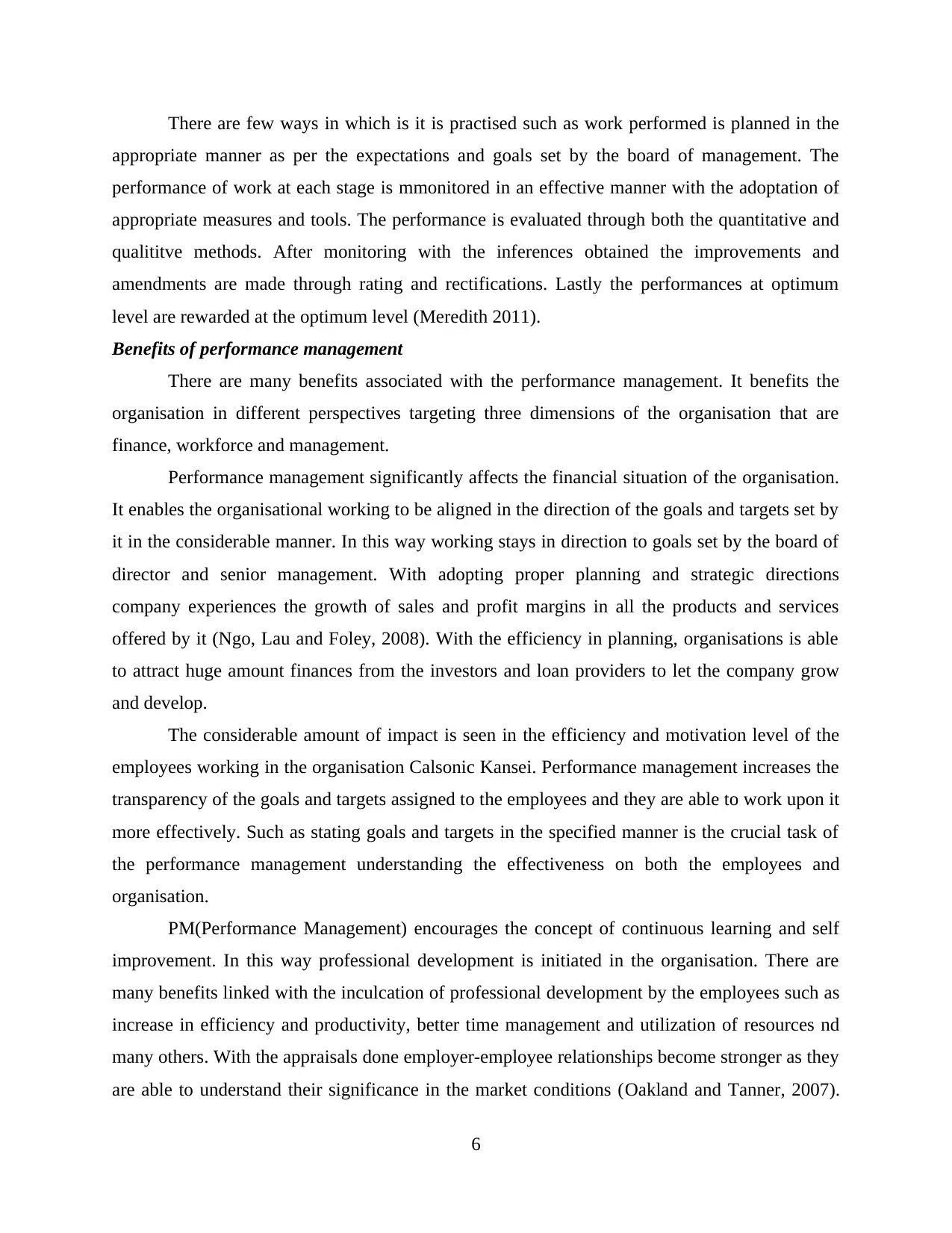
There are few ways in which is it is practised such as work performed is planned in the
appropriate manner as per the expectations and goals set by the board of management. The
performance of work at each stage is mmonitored in an effective manner with the adoptation of
appropriate measures and tools. The performance is evaluated through both the quantitative and
qualititve methods. After monitoring with the inferences obtained the improvements and
amendments are made through rating and rectifications. Lastly the performances at optimum
level are rewarded at the optimum level (Meredith 2011).
Benefits of performance management
There are many benefits associated with the performance management. It benefits the
organisation in different perspectives targeting three dimensions of the organisation that are
finance, workforce and management.
Performance management significantly affects the financial situation of the organisation.
It enables the organisational working to be aligned in the direction of the goals and targets set by
it in the considerable manner. In this way working stays in direction to goals set by the board of
director and senior management. With adopting proper planning and strategic directions
company experiences the growth of sales and profit margins in all the products and services
offered by it (Ngo, Lau and Foley, 2008). With the efficiency in planning, organisations is able
to attract huge amount finances from the investors and loan providers to let the company grow
and develop.
The considerable amount of impact is seen in the efficiency and motivation level of the
employees working in the organisation Calsonic Kansei. Performance management increases the
transparency of the goals and targets assigned to the employees and they are able to work upon it
more effectively. Such as stating goals and targets in the specified manner is the crucial task of
the performance management understanding the effectiveness on both the employees and
organisation.
PM(Performance Management) encourages the concept of continuous learning and self
improvement. In this way professional development is initiated in the organisation. There are
many benefits linked with the inculcation of professional development by the employees such as
increase in efficiency and productivity, better time management and utilization of resources nd
many others. With the appraisals done employer-employee relationships become stronger as they
are able to understand their significance in the market conditions (Oakland and Tanner, 2007).
6
appropriate manner as per the expectations and goals set by the board of management. The
performance of work at each stage is mmonitored in an effective manner with the adoptation of
appropriate measures and tools. The performance is evaluated through both the quantitative and
qualititve methods. After monitoring with the inferences obtained the improvements and
amendments are made through rating and rectifications. Lastly the performances at optimum
level are rewarded at the optimum level (Meredith 2011).
Benefits of performance management
There are many benefits associated with the performance management. It benefits the
organisation in different perspectives targeting three dimensions of the organisation that are
finance, workforce and management.
Performance management significantly affects the financial situation of the organisation.
It enables the organisational working to be aligned in the direction of the goals and targets set by
it in the considerable manner. In this way working stays in direction to goals set by the board of
director and senior management. With adopting proper planning and strategic directions
company experiences the growth of sales and profit margins in all the products and services
offered by it (Ngo, Lau and Foley, 2008). With the efficiency in planning, organisations is able
to attract huge amount finances from the investors and loan providers to let the company grow
and develop.
The considerable amount of impact is seen in the efficiency and motivation level of the
employees working in the organisation Calsonic Kansei. Performance management increases the
transparency of the goals and targets assigned to the employees and they are able to work upon it
more effectively. Such as stating goals and targets in the specified manner is the crucial task of
the performance management understanding the effectiveness on both the employees and
organisation.
PM(Performance Management) encourages the concept of continuous learning and self
improvement. In this way professional development is initiated in the organisation. There are
many benefits linked with the inculcation of professional development by the employees such as
increase in efficiency and productivity, better time management and utilization of resources nd
many others. With the appraisals done employer-employee relationships become stronger as they
are able to understand their significance in the market conditions (Oakland and Tanner, 2007).
6
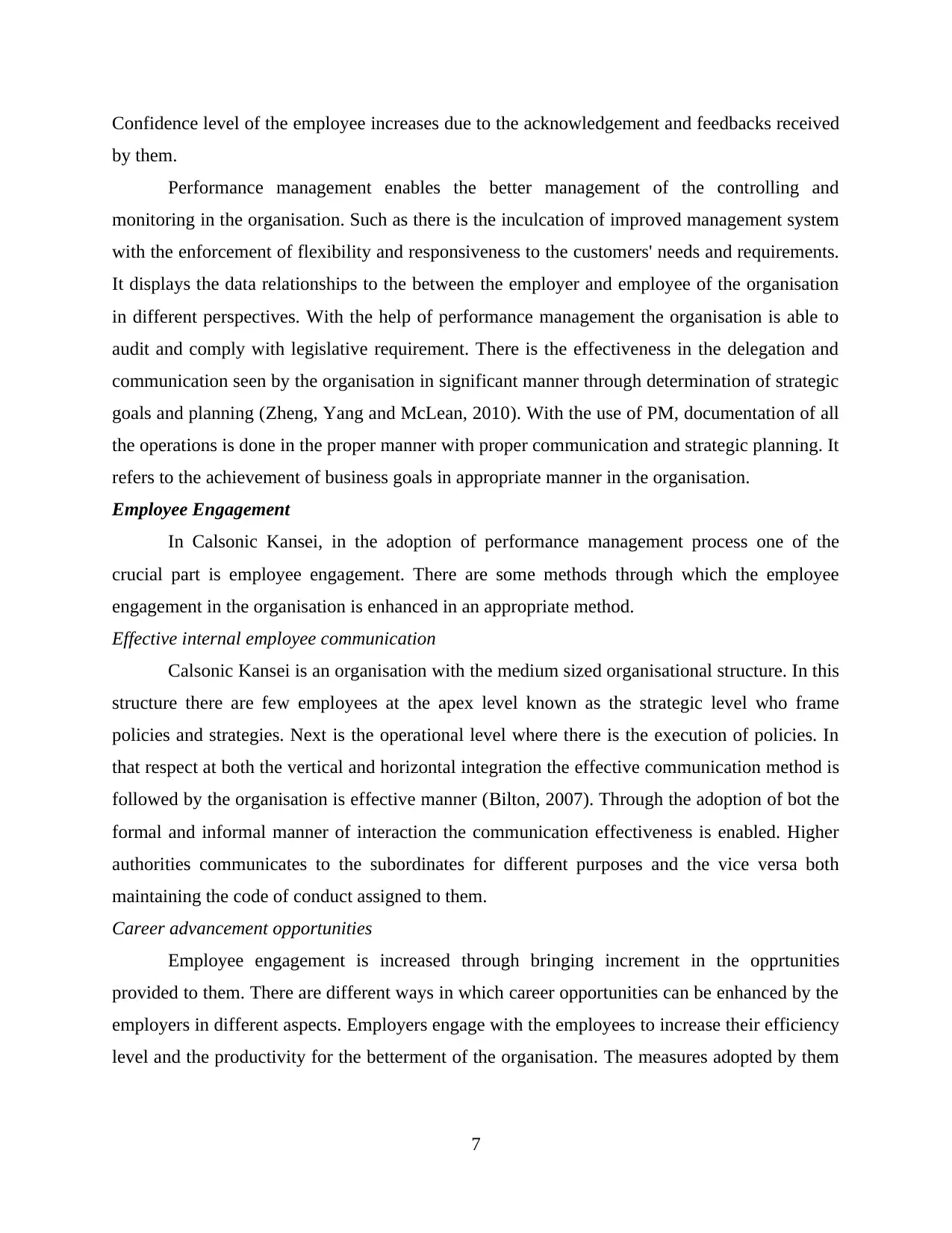
Confidence level of the employee increases due to the acknowledgement and feedbacks received
by them.
Performance management enables the better management of the controlling and
monitoring in the organisation. Such as there is the inculcation of improved management system
with the enforcement of flexibility and responsiveness to the customers' needs and requirements.
It displays the data relationships to the between the employer and employee of the organisation
in different perspectives. With the help of performance management the organisation is able to
audit and comply with legislative requirement. There is the effectiveness in the delegation and
communication seen by the organisation in significant manner through determination of strategic
goals and planning (Zheng, Yang and McLean, 2010). With the use of PM, documentation of all
the operations is done in the proper manner with proper communication and strategic planning. It
refers to the achievement of business goals in appropriate manner in the organisation.
Employee Engagement
In Calsonic Kansei, in the adoption of performance management process one of the
crucial part is employee engagement. There are some methods through which the employee
engagement in the organisation is enhanced in an appropriate method.
Effective internal employee communication
Calsonic Kansei is an organisation with the medium sized organisational structure. In this
structure there are few employees at the apex level known as the strategic level who frame
policies and strategies. Next is the operational level where there is the execution of policies. In
that respect at both the vertical and horizontal integration the effective communication method is
followed by the organisation is effective manner (Bilton, 2007). Through the adoption of bot the
formal and informal manner of interaction the communication effectiveness is enabled. Higher
authorities communicates to the subordinates for different purposes and the vice versa both
maintaining the code of conduct assigned to them.
Career advancement opportunities
Employee engagement is increased through bringing increment in the opprtunities
provided to them. There are different ways in which career opportunities can be enhanced by the
employers in different aspects. Employers engage with the employees to increase their efficiency
level and the productivity for the betterment of the organisation. The measures adopted by them
7
by them.
Performance management enables the better management of the controlling and
monitoring in the organisation. Such as there is the inculcation of improved management system
with the enforcement of flexibility and responsiveness to the customers' needs and requirements.
It displays the data relationships to the between the employer and employee of the organisation
in different perspectives. With the help of performance management the organisation is able to
audit and comply with legislative requirement. There is the effectiveness in the delegation and
communication seen by the organisation in significant manner through determination of strategic
goals and planning (Zheng, Yang and McLean, 2010). With the use of PM, documentation of all
the operations is done in the proper manner with proper communication and strategic planning. It
refers to the achievement of business goals in appropriate manner in the organisation.
Employee Engagement
In Calsonic Kansei, in the adoption of performance management process one of the
crucial part is employee engagement. There are some methods through which the employee
engagement in the organisation is enhanced in an appropriate method.
Effective internal employee communication
Calsonic Kansei is an organisation with the medium sized organisational structure. In this
structure there are few employees at the apex level known as the strategic level who frame
policies and strategies. Next is the operational level where there is the execution of policies. In
that respect at both the vertical and horizontal integration the effective communication method is
followed by the organisation is effective manner (Bilton, 2007). Through the adoption of bot the
formal and informal manner of interaction the communication effectiveness is enabled. Higher
authorities communicates to the subordinates for different purposes and the vice versa both
maintaining the code of conduct assigned to them.
Career advancement opportunities
Employee engagement is increased through bringing increment in the opprtunities
provided to them. There are different ways in which career opportunities can be enhanced by the
employers in different aspects. Employers engage with the employees to increase their efficiency
level and the productivity for the betterment of the organisation. The measures adopted by them
7
⊘ This is a preview!⊘
Do you want full access?
Subscribe today to unlock all pages.

Trusted by 1+ million students worldwide
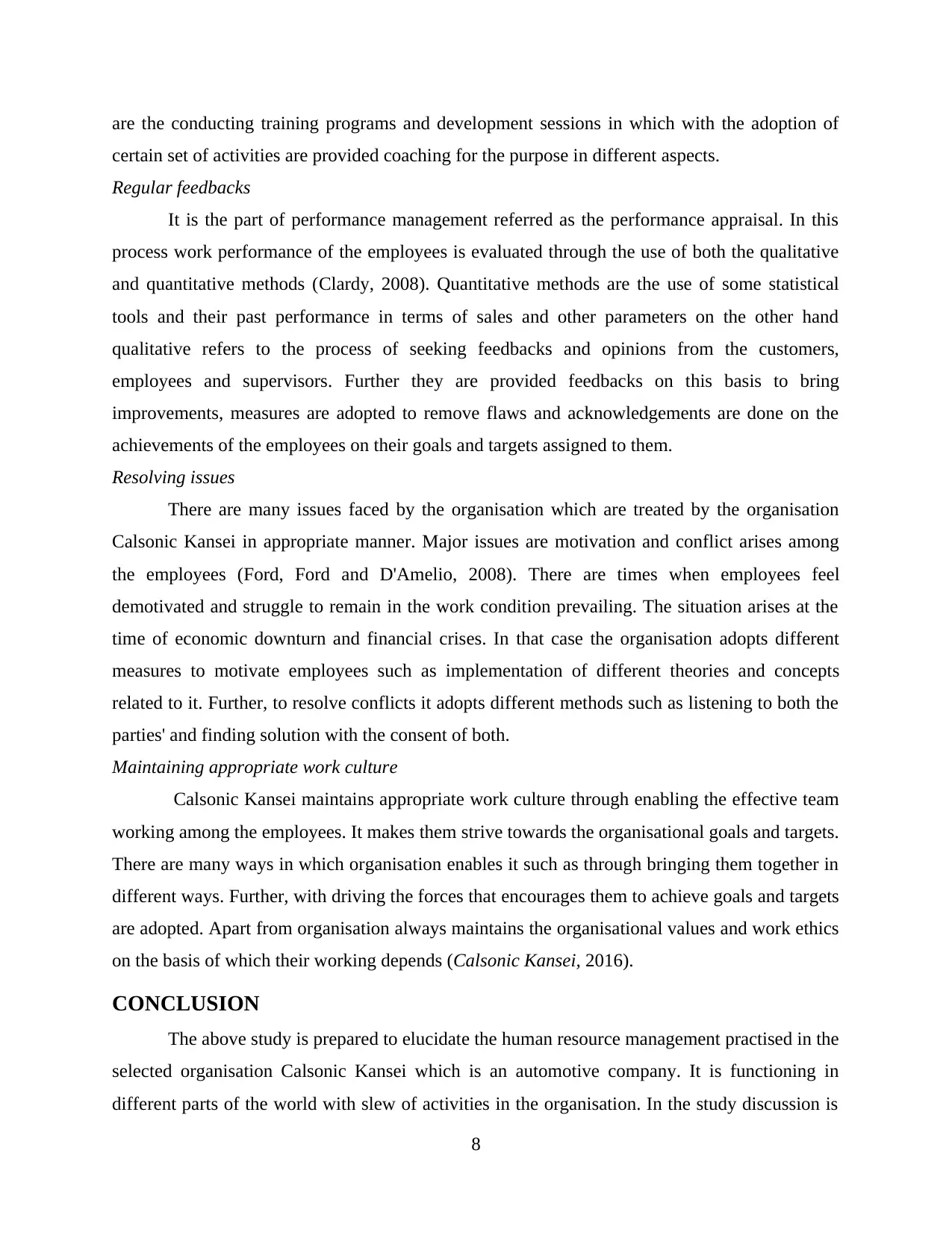
are the conducting training programs and development sessions in which with the adoption of
certain set of activities are provided coaching for the purpose in different aspects.
Regular feedbacks
It is the part of performance management referred as the performance appraisal. In this
process work performance of the employees is evaluated through the use of both the qualitative
and quantitative methods (Clardy, 2008). Quantitative methods are the use of some statistical
tools and their past performance in terms of sales and other parameters on the other hand
qualitative refers to the process of seeking feedbacks and opinions from the customers,
employees and supervisors. Further they are provided feedbacks on this basis to bring
improvements, measures are adopted to remove flaws and acknowledgements are done on the
achievements of the employees on their goals and targets assigned to them.
Resolving issues
There are many issues faced by the organisation which are treated by the organisation
Calsonic Kansei in appropriate manner. Major issues are motivation and conflict arises among
the employees (Ford, Ford and D'Amelio, 2008). There are times when employees feel
demotivated and struggle to remain in the work condition prevailing. The situation arises at the
time of economic downturn and financial crises. In that case the organisation adopts different
measures to motivate employees such as implementation of different theories and concepts
related to it. Further, to resolve conflicts it adopts different methods such as listening to both the
parties' and finding solution with the consent of both.
Maintaining appropriate work culture
Calsonic Kansei maintains appropriate work culture through enabling the effective team
working among the employees. It makes them strive towards the organisational goals and targets.
There are many ways in which organisation enables it such as through bringing them together in
different ways. Further, with driving the forces that encourages them to achieve goals and targets
are adopted. Apart from organisation always maintains the organisational values and work ethics
on the basis of which their working depends (Calsonic Kansei, 2016).
CONCLUSION
The above study is prepared to elucidate the human resource management practised in the
selected organisation Calsonic Kansei which is an automotive company. It is functioning in
different parts of the world with slew of activities in the organisation. In the study discussion is
8
certain set of activities are provided coaching for the purpose in different aspects.
Regular feedbacks
It is the part of performance management referred as the performance appraisal. In this
process work performance of the employees is evaluated through the use of both the qualitative
and quantitative methods (Clardy, 2008). Quantitative methods are the use of some statistical
tools and their past performance in terms of sales and other parameters on the other hand
qualitative refers to the process of seeking feedbacks and opinions from the customers,
employees and supervisors. Further they are provided feedbacks on this basis to bring
improvements, measures are adopted to remove flaws and acknowledgements are done on the
achievements of the employees on their goals and targets assigned to them.
Resolving issues
There are many issues faced by the organisation which are treated by the organisation
Calsonic Kansei in appropriate manner. Major issues are motivation and conflict arises among
the employees (Ford, Ford and D'Amelio, 2008). There are times when employees feel
demotivated and struggle to remain in the work condition prevailing. The situation arises at the
time of economic downturn and financial crises. In that case the organisation adopts different
measures to motivate employees such as implementation of different theories and concepts
related to it. Further, to resolve conflicts it adopts different methods such as listening to both the
parties' and finding solution with the consent of both.
Maintaining appropriate work culture
Calsonic Kansei maintains appropriate work culture through enabling the effective team
working among the employees. It makes them strive towards the organisational goals and targets.
There are many ways in which organisation enables it such as through bringing them together in
different ways. Further, with driving the forces that encourages them to achieve goals and targets
are adopted. Apart from organisation always maintains the organisational values and work ethics
on the basis of which their working depends (Calsonic Kansei, 2016).
CONCLUSION
The above study is prepared to elucidate the human resource management practised in the
selected organisation Calsonic Kansei which is an automotive company. It is functioning in
different parts of the world with slew of activities in the organisation. In the study discussion is
8
Paraphrase This Document
Need a fresh take? Get an instant paraphrase of this document with our AI Paraphraser
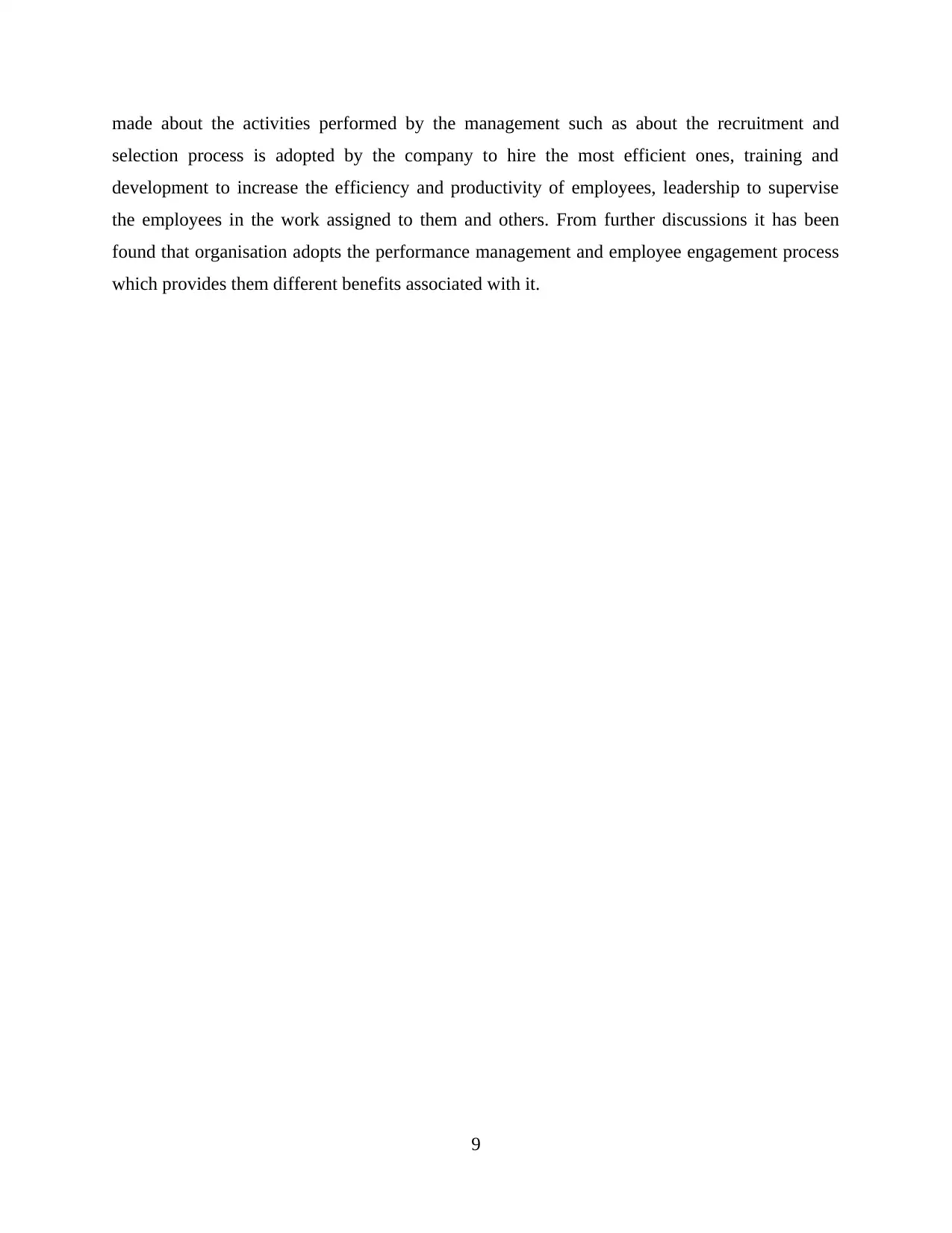
made about the activities performed by the management such as about the recruitment and
selection process is adopted by the company to hire the most efficient ones, training and
development to increase the efficiency and productivity of employees, leadership to supervise
the employees in the work assigned to them and others. From further discussions it has been
found that organisation adopts the performance management and employee engagement process
which provides them different benefits associated with it.
9
selection process is adopted by the company to hire the most efficient ones, training and
development to increase the efficiency and productivity of employees, leadership to supervise
the employees in the work assigned to them and others. From further discussions it has been
found that organisation adopts the performance management and employee engagement process
which provides them different benefits associated with it.
9
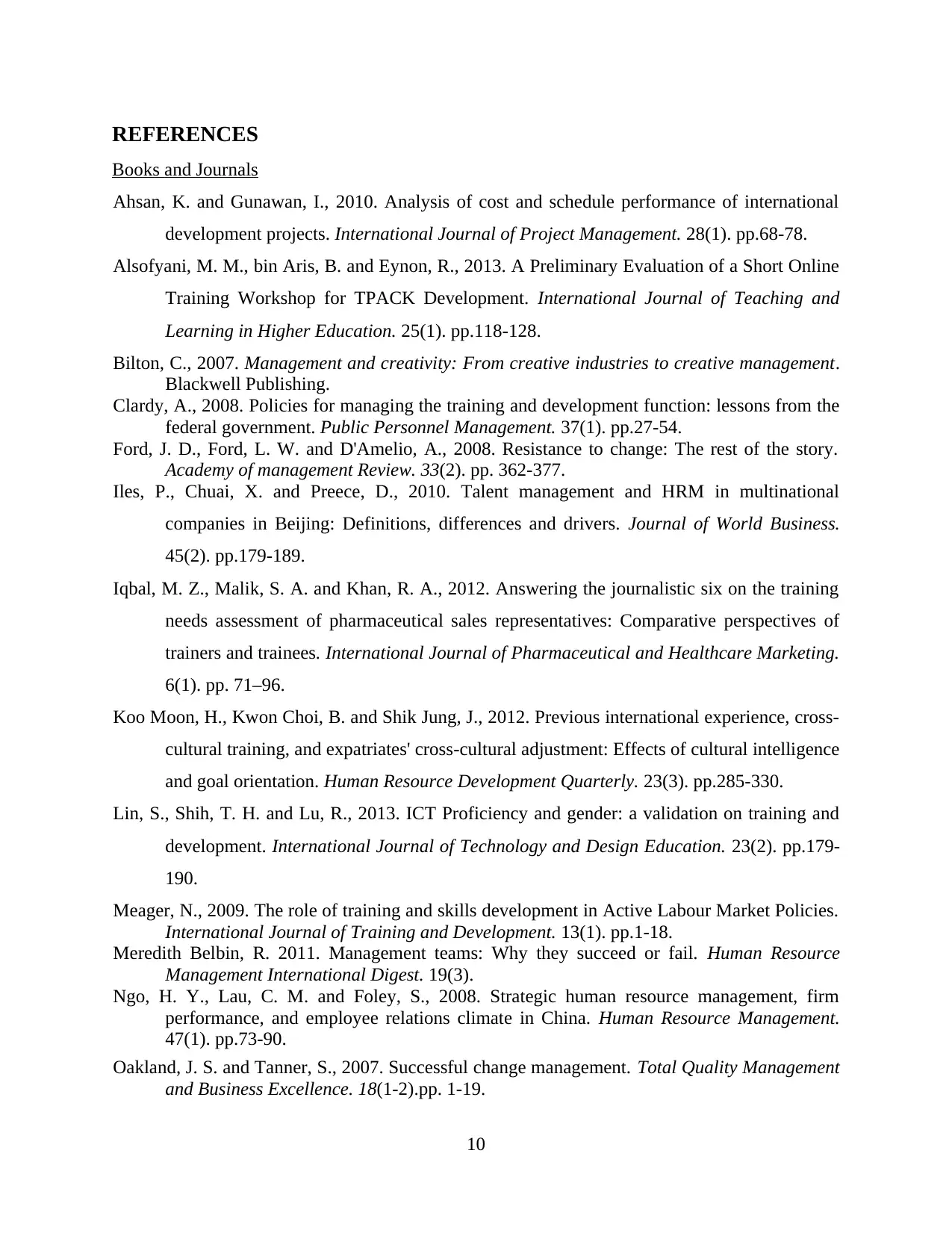
REFERENCES
Books and Journals
Ahsan, K. and Gunawan, I., 2010. Analysis of cost and schedule performance of international
development projects. International Journal of Project Management. 28(1). pp.68-78.
Alsofyani, M. M., bin Aris, B. and Eynon, R., 2013. A Preliminary Evaluation of a Short Online
Training Workshop for TPACK Development. International Journal of Teaching and
Learning in Higher Education. 25(1). pp.118-128.
Bilton, C., 2007. Management and creativity: From creative industries to creative management.
Blackwell Publishing.
Clardy, A., 2008. Policies for managing the training and development function: lessons from the
federal government. Public Personnel Management. 37(1). pp.27-54.
Ford, J. D., Ford, L. W. and D'Amelio, A., 2008. Resistance to change: The rest of the story.
Academy of management Review. 33(2). pp. 362-377.
Iles, P., Chuai, X. and Preece, D., 2010. Talent management and HRM in multinational
companies in Beijing: Definitions, differences and drivers. Journal of World Business.
45(2). pp.179-189.
Iqbal, M. Z., Malik, S. A. and Khan, R. A., 2012. Answering the journalistic six on the training
needs assessment of pharmaceutical sales representatives: Comparative perspectives of
trainers and trainees. International Journal of Pharmaceutical and Healthcare Marketing.
6(1). pp. 71–96.
Koo Moon, H., Kwon Choi, B. and Shik Jung, J., 2012. Previous international experience, cross‐
cultural training, and expatriates' cross‐cultural adjustment: Effects of cultural intelligence
and goal orientation. Human Resource Development Quarterly. 23(3). pp.285-330.
Lin, S., Shih, T. H. and Lu, R., 2013. ICT Proficiency and gender: a validation on training and
development. International Journal of Technology and Design Education. 23(2). pp.179-
190.
Meager, N., 2009. The role of training and skills development in Active Labour Market Policies.
International Journal of Training and Development. 13(1). pp.1-18.
Meredith Belbin, R. 2011. Management teams: Why they succeed or fail. Human Resource
Management International Digest. 19(3).
Ngo, H. Y., Lau, C. M. and Foley, S., 2008. Strategic human resource management, firm
performance, and employee relations climate in China. Human Resource Management.
47(1). pp.73-90.
Oakland, J. S. and Tanner, S., 2007. Successful change management. Total Quality Management
and Business Excellence. 18(1-2).pp. 1-19.
10
Books and Journals
Ahsan, K. and Gunawan, I., 2010. Analysis of cost and schedule performance of international
development projects. International Journal of Project Management. 28(1). pp.68-78.
Alsofyani, M. M., bin Aris, B. and Eynon, R., 2013. A Preliminary Evaluation of a Short Online
Training Workshop for TPACK Development. International Journal of Teaching and
Learning in Higher Education. 25(1). pp.118-128.
Bilton, C., 2007. Management and creativity: From creative industries to creative management.
Blackwell Publishing.
Clardy, A., 2008. Policies for managing the training and development function: lessons from the
federal government. Public Personnel Management. 37(1). pp.27-54.
Ford, J. D., Ford, L. W. and D'Amelio, A., 2008. Resistance to change: The rest of the story.
Academy of management Review. 33(2). pp. 362-377.
Iles, P., Chuai, X. and Preece, D., 2010. Talent management and HRM in multinational
companies in Beijing: Definitions, differences and drivers. Journal of World Business.
45(2). pp.179-189.
Iqbal, M. Z., Malik, S. A. and Khan, R. A., 2012. Answering the journalistic six on the training
needs assessment of pharmaceutical sales representatives: Comparative perspectives of
trainers and trainees. International Journal of Pharmaceutical and Healthcare Marketing.
6(1). pp. 71–96.
Koo Moon, H., Kwon Choi, B. and Shik Jung, J., 2012. Previous international experience, cross‐
cultural training, and expatriates' cross‐cultural adjustment: Effects of cultural intelligence
and goal orientation. Human Resource Development Quarterly. 23(3). pp.285-330.
Lin, S., Shih, T. H. and Lu, R., 2013. ICT Proficiency and gender: a validation on training and
development. International Journal of Technology and Design Education. 23(2). pp.179-
190.
Meager, N., 2009. The role of training and skills development in Active Labour Market Policies.
International Journal of Training and Development. 13(1). pp.1-18.
Meredith Belbin, R. 2011. Management teams: Why they succeed or fail. Human Resource
Management International Digest. 19(3).
Ngo, H. Y., Lau, C. M. and Foley, S., 2008. Strategic human resource management, firm
performance, and employee relations climate in China. Human Resource Management.
47(1). pp.73-90.
Oakland, J. S. and Tanner, S., 2007. Successful change management. Total Quality Management
and Business Excellence. 18(1-2).pp. 1-19.
10
⊘ This is a preview!⊘
Do you want full access?
Subscribe today to unlock all pages.

Trusted by 1+ million students worldwide
1 out of 13
Related Documents
Your All-in-One AI-Powered Toolkit for Academic Success.
+13062052269
info@desklib.com
Available 24*7 on WhatsApp / Email
![[object Object]](/_next/static/media/star-bottom.7253800d.svg)
Unlock your academic potential
Copyright © 2020–2025 A2Z Services. All Rights Reserved. Developed and managed by ZUCOL.




